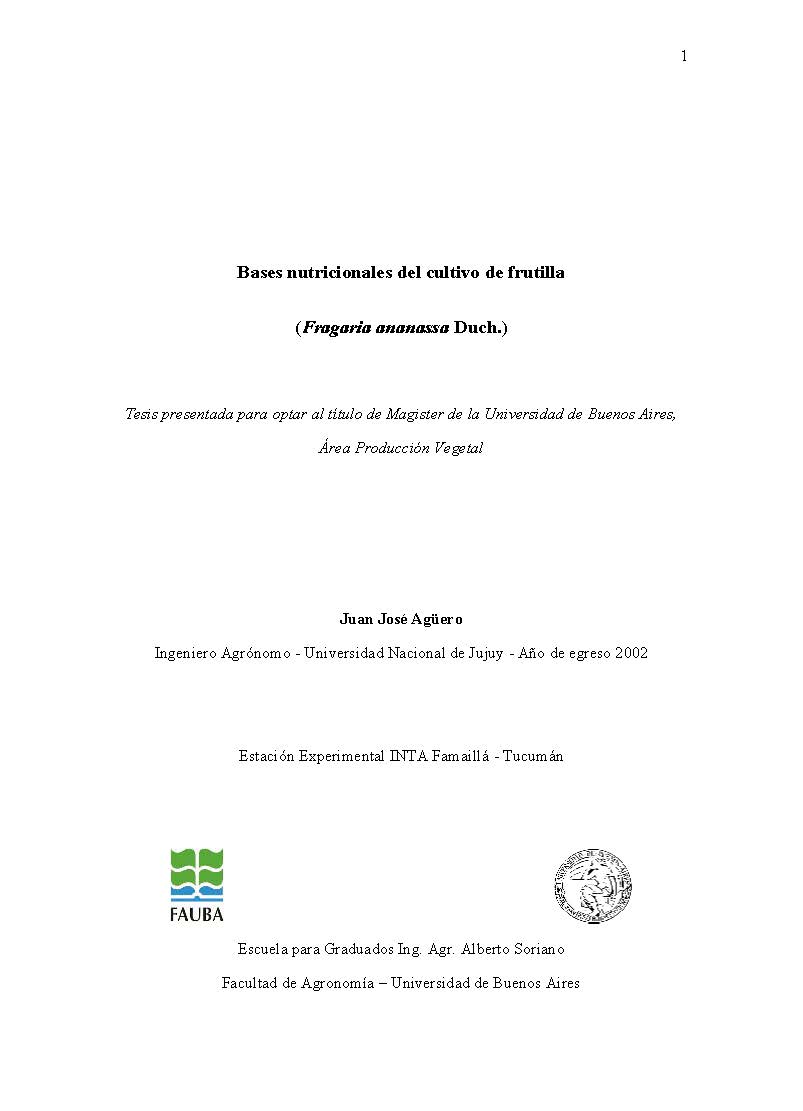Ver ítem
- xmlui.general.dspace_homeCentros Regionales y EEAsCentro Regional Tucumán - Santiago del EsteroEEA FamailláTesisxmlui.ArtifactBrowser.ItemViewer.trail
- Inicio
- Centros Regionales y EEAs
- Centro Regional Tucumán - Santiago del Estero
- EEA Famaillá
- Tesis
- Ver ítem
Bases nutricionales del cultivo de frutilla (Fragaria ananassa Duch.)
Resumen
El sistema de producción invernal de frutilla, dominado por 'Camarosa'., tiende a ampliar su espectro varietal. Las recomendaciones actuales de fertilización no consideran particularidades genéticas ni eficiencia en el uso de los nutrientes (EUNu). Los objetivos de este trabajo de tesis son: estudiar la respuesta de cultivares de frutilla contrastantes en morfología y fisiología a incrementos en la fertilización NPKCaMg, determinar e interpretar índices
[ver mas...]
El sistema de producción invernal de frutilla, dominado por 'Camarosa'., tiende a ampliar su espectro varietal. Las recomendaciones actuales de fertilización no consideran particularidades genéticas ni eficiencia en el uso de los nutrientes (EUNu). Los objetivos de este trabajo de tesis son: estudiar la respuesta de cultivares de frutilla contrastantes en morfología y fisiología a incrementos en la fertilización NPKCaMg, determinar e interpretar índices de EUNu y cuantificar efectos ambientales, genotípicos y nutricionales sobre los atributos de calidad de frutos. Se evaluaron 'Camarosa'., 'Camino Real', 'Sabrosa' y 'Ventana' ante incrementos en la fertilización, a partir de un tratamiento testigo '1' (120N, 30P, 186K, 31Ca y 12Mg kg/ha) proporcionalmente a '1,5' en 2006, '1,33' y '1,66' en 2007, '1,5' y '2' en 2008. Esto determinó una respuesta genotípica diferencial cuadrática que definió dosis óptimas: 'Camarosa' 15 por ciento a dosis 1,53, 'Camino Real' 6 por ciento a dosis 1,36, 'Sabrosa' 4 por ciento a dosis 1,29 y 'Ventana' 19 por ciento a dosis 1,59. A mitad del ciclo, el número de hojas se correlacionó con el rendimiento total y los cultivares de mayor respuesta mostraron mayor K y menor Ca foliar, acentuado al aumentar la fertilización. La productividad del nutriente aportado (rendimiento/fertilización) resultó mayor en cultivares más productivos y de mayor respuesta. El balance de nutrientes (absorción/fertilización) dependió de la interacción genotipo por ambiente. La eficiencia de recuperación (absorción/fertilización) fue proporcional a la respuesta a la fertilización. Los coeficientes de eficiencia interna (biomasa/absorción y rendimiento/absorción) resultaron diferentes entre cultivares y consistentes entre tratamientos de fertilización. Peso de fruto y sólidos solubles totales variaron con la interacción genotipo por ambiente; firmeza, tono de color, y acidez con el genotipo y el ambiente; ninguno de ellos varió la nutrición. Los resultados sientan bases nutricionales para el cultivo de frutilla, en cuanto a la absorción genotípico-diferencial de nutrientes y sus efectos en el crecimiento, producción y EUNu.
[Cerrar]
Strawberry winter production systems, dominated by „Camarosa‟, tend to expand the varietal spectrum. Nowadays, fertilizers are applied without considering
cultivar particularities and nutrient use efficiency (NuUE). The objectives of this thesis are: to study the response of strawberry cultivars contrasting in morphology and physiology to increased fertilization NPKCaMg, determine and interpret NuUE indexes,
and quantify environmental, genotypic and
[ver mas...]
Strawberry winter production systems, dominated by „Camarosa‟, tend to expand the varietal spectrum. Nowadays, fertilizers are applied without considering
cultivar particularities and nutrient use efficiency (NuUE). The objectives of this thesis are: to study the response of strawberry cultivars contrasting in morphology and physiology to increased fertilization NPKCaMg, determine and interpret NuUE indexes,
and quantify environmental, genotypic and nutritional effects on attributes of fruit quality. „Camarosa‟, „Camino Real‟, „Sabrosa‟ and „Ventana‟ cultivars were exposed to increased fertilization, from a control treatment “1” (120N, 30P, 186K, 31Ca and 120Mg kg/ha), proportionally to “1.5” in 2006, “1.33” and “1.66” in 2007, “1.5” and “2” in 2008. This led to a quadratic differential genotypic response that defines optimal doses: „Camarosa‟ 15 % at doses 1.53, „Camino Real‟ 6% at doses 1.36, „Sabrosa‟ 4 % at doses 1.29 and „Ventana‟ 19 % at doses 1.59. At middle of cycle, number of leaves was correlated with total yields and the most responsive cultivars showed the highest levels of leaf K and the lowest levels of leaf Ca, accentuated with increased fertilization.
Productivity from applied nutrient (yields/fertilization) was greater in the most productive and responsive to fertilization cultivars. Nutrient budget (uptake/fertilization) depended on genotype × environment interaction. Recovery efficiency (Δuptake/Δfertilization) was proportional to the response to fertilization. Nutrient efficiency ratios in terms of biomass and yields (biomass/uptake and
yields/uptake) were different among cultivars and consistents between fertilization treatments. Fruit weight and total soluble solids varied with genotype × environment interaction; firmness, color tone, and acidity varied with genotype and environment; none of them varied with nutrition. The results provide nutritional base for strawberries cultivation, in terms of the nutrient genotypic-differential uptake and their effects on plant growth, production and NuUE.
[Cerrar]

Autor
Director de Tesis
Descripción
Tesis para obtener el grado de Magister en área Producción Vegetal, de la Universidad de Buenos Aires, en 2012
Fecha
2012-10
Editorial
Facultad de Agronomía, Universidad de Buenos Aires
Formato
pdf
Tipo de documento
tesis de maestría
Palabras Claves
Derechos de acceso
Abierto
 Excepto donde se diga explicitamente, este item se publica bajo la siguiente descripción: Creative Commons Attribution-NonCommercial-ShareAlike 2.5 Unported (CC BY-NC-SA 2.5)
Excepto donde se diga explicitamente, este item se publica bajo la siguiente descripción: Creative Commons Attribution-NonCommercial-ShareAlike 2.5 Unported (CC BY-NC-SA 2.5)


